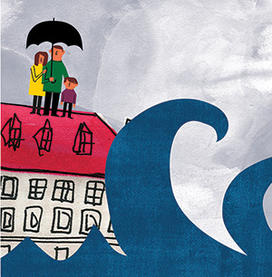Ning Lin *10 Studies Extreme Weather
Ning Lin *10 was always fascinated by physics, math, and architecture — particularly when the disciplines came together in the process of ensuring building safety. As a civil engineering student at Huazhong University of Science and Technology in Wuhan, China, she became interested in the effects of environmental stressors on structures.
“A lot of the topics I’m working on now are motivated by real cases,” Ning Lin *10 explains.
Wind in particular seemed to have a large yet understudied impact. This discovery led Lin to home in on the effects of wind — as well as hurricanes, heat, and flooding — on buildings and other structures throughout her graduate work at Texas Tech University and Princeton, where she earned her Ph.D. in civil and environmental engineering.
Lin’s Research: A Sampling

Heat Wave
As the Earth continues to heat up, tropical storms are expected to become more common. This combination of events is particularly troubling, Lin says, as hurricanes have a tendency to knock out power grids just when people are desperate to use their air conditioners. “Heat waves are the leading cause of weather-induced fatalities in the United States,” she notes. In a 2022 paper, Lin and her research partners estimated that the number of residents in Harris County, Texas, who will experience at least one five-plus-day, tropical-cyclone-induced blackout during a heatwave will increase 23 times over the course of this century.

Prepare for Emergencies
In the summer of 2017, Hurricane Harvey struck Houston, Texas, Hurricane Irma hit South Florida, and Hurricane Maria decimated Puerto Rico. Four years later in 2021, Hurricane Ida struck Louisiana while Hurricane Nicholas hit Texas. “If these multiple events are happening, and people have not recovered from the previous event, how can they deal with the next one?” Lin says. Using computer simulations, Lin and her team found that the threat of multiple hurricanes will increase, because the severity of each storm will be greater. That means the effects of each storm — such as flooding and loss of power — will be compounded, resulting in greater destruction and more challenges to recovery.

Mapping Risk
Thanks to climate change, the likelihood of coastal areas experiencing both extreme rainfall and storm surges is increasing. To plan accordingly, people living and working in these areas need to know their compound flood risk: the level of flooding they can expect from rain and storm surges combined. But to calculate that is a highly complex, expensive task that requires physical measurements and modeling, Lin notes. So she and her research partner developed a new methodology, which they published in a 2022 report, that relies on existing physical models and applies a novel statistical approach “to be able to project compound flood hazards in different climate scenarios for specific local [communities]” at a fraction of the cost. In a simulation, they applied their approach to the Cape Fear River area in North Carolina and revealed a 27% increase in the extent of and 62% increase in the volume of floods over a 100-year period.












No responses yet